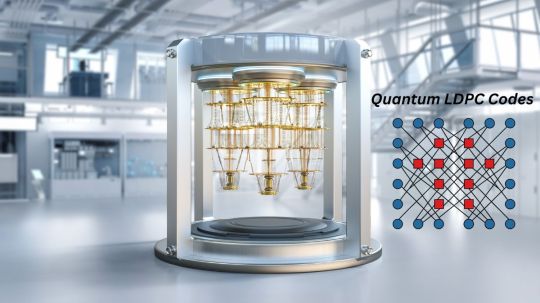#QuantumLDPCcodes
Explore tagged Tumblr posts
Text
Bias-Tailored Quantum LDPC Codes Boost Quantum Computing

Quantum-LDPC codes
University of Southern California researchers made a major quantum error correction (QEC) breakthrough, which is essential to developing quantum computers. Their unique technology, outlined in “Bias-Tailored Quantum LDPC codes,” creates a new family of “bias-tailored” quantum codes to improve fault tolerance and speed up quantum computation by exploiting quantum hardware faults.
Environmental noise can produce qubit decoherence and errors, compromising computation integrity. Due to its fragility, quantum operations require robust error correction. Reduce computational resources for efficient error mitigation is a serious challenge for researchers.
Understanding and Using Noise Asymmetry
Our research is driven by the discovery that quantum technology often exhibits an imbalance between mistake types. These errors usually appear as:
Bit-flip errors: Qubit (0 or 1) reversals.
Phase-flip faults affect quantum superposition.
Inaccuracies are often more widespread in one type. In superconducting qubit systems, phase-noise can be five orders of magnitude stronger.
This imbalance is instantly rectified by “bias-tailoring”. These programs adjust to the most common error type rather than handling all errors identically. This boosts computing performance and reduces fault tolerance resources. As shown by the Hashing threshold, a lower bound on the physical error rate below which a quantum code can theoretically suppress mistakes, this strategy allows quantum codes to take advantage of higher noise bias's increased channel capacity. The threshold for depolarising noise is 18.9%, but infinite bias raises it to 50%, providing strong theoretical support for bias-tailoring.
Single-Shot Decoding for Fast Recovery
In addition to bias-tailoring, the researchers introduced “single-shot” decoding. This unique method recovers data from noisy measurements in a single processing cycle, avoiding repetitive decoding delays and speeding computation.
A New Code Hierarchy: Bias-Tailored Lifted Product
Shixin Wu, Todd A. Brun, and Daniel A. Lidar from the University of Southern California lead the study to create a hierarchy of new codes. These are based on the hypergraph product code, which can combine smaller quantum codes into larger, more durable ones. The researchers created two code versions with differing error repair and resource allocation advantages by deliberately removing “stabiliser blocks” operators that discover flaws without destroying quantum information.
Joschka Roffe et al. in Quantum additionally highlighted wider research on bias-tailored low-density parity-check (LDPC) codes and how they can exploit qubit noise asymmetry. Quantum LDPC codes may encode several qubits per logical block, enabling fault-tolerant processing, making them a potential replacement for surface codes, especially for long-range quantum structures.
The unique “bias-tailored lifted product” structure provides a flexible framework for bias-tailoring beyond 2D topological codes like the XZZX code. This framework extends the quantum code's effective distance in the limit of infinite bias by modifying the stabilisers of lifted product codes, allowing them to fully use biassed error channels.
Two novel code variants:
This version simplifies code to maximise resource optimisation. Stabiliser measurements and physical qubits are cut in half. The minimal distance that quadratically grows compared to typical designs allows this while maintaining excellent error correction capabilities.
Reduced Code: This version compromises but decreases hardware needs similarly. In exchange for single-shot protection against bit-flip or phase-flip noise, it preserves single-shot functioning under balanced noise or depolarising noise, which randomly modifies a qubit's state. Designers can adapt performance to quantum gear's specific properties.
Practice and Performance
To illustrate, USC researchers created a “3D XZZX” code by expanding the popular two-dimensional surface code to a cubic lattice. This reduced code family addition proves their theoretical framework. Surface codes are popular due to their high error thresholds and planar structural compatibility.
In asymmetric noise situations, bias-tailored lifting product codes can suppress errors by several orders of magnitude better than depolarising noise, according to numerical simulations using Belief Propagation plus Ordered Statistics Decoding. As X-bias rose, a bias-tailored lifted product code beat conventional codes and reduced word mistakes. The XZZX toric code, notable for its performance under biassed noise, may be readily derived as a special example of the bias-tailored lifted product, demonstrating its wide applicability.
Due to their lower qubit overheads than surface codes, quantum LDPC codes can encode more logical qubits at a comparable word error rate, enabling scalable quantum storage.
To Scalable and Reliable Quantum Computers
This research helps build practical and effective quantum computers. These innovative codes handle noisy quantum hardware and optimise resource efficiency through bias-tailoring and single-shot decoding to provide scalable and reliable quantum systems for real-world use. The versatility of these code design possibilities allows variable trade-offs between noise characteristics and hardware overhead, enabling future quantum machines to address difficult computing problems.
#QuantumLDPCcodes#quantumerrorcorrection#LDPCcodes#superconductingqubit#News#Technews#Technology#Technologynews#Technologytrends#Govindhtech
0 notes